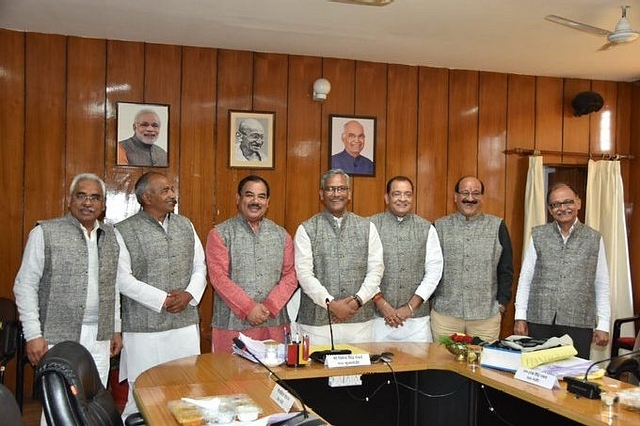
These Jackets Worn By Chief Minister Rawat And Team Could Turn Around The Livelihood Story Of Women In Uttarakhand
Uttarakhand Chief Minister Trivendra Singh Rawat thought of a novel way of promoting a weave from the state. At a cabinet meeting held in Dehradun, Rawat, along with members of his cabinet wore jackets woven from the Kandali grass fibre.
A discussion on 30 vital issues was held at this meeting. By wearing jackets made of the Himalayan Nettle fibre, Rawat and his team not only ‘wore’ a cause, but also propelled a message: on taking the use of available natural resources to improve livelihoods, seriously.
Rawat's own interest in using agriculture and agro-forest products for bettering lives in Uttarakhand is huge.
He is pitching for localisation within Uttarakhand, and pushing for utilising the available resources towards improving lives and livelihoods as one of the several measures to empower work to curb out-migration.
Products made out of Kandali and other plants are popular at local exhibitions. The processing, spinning and weaving are being encouraged in the state. As for the fibre, it is light-weight, strong and ‘breathes’. Its use is becoming popular, as is of fibre from grasses such as Bhang, Bhimal, Rambans and Bhabar.
What is Kandali? It is known as bichchu ghaas. Bichchu — in English — is scorpion.
In Kumaoni, which is the language of the Kumaon region, it is called sirsauna. In English, it is known as stinging nettle. The most intriguing quality of this plant is its ability to make you ‘feel’ the sting, and as those humble folks who have been ‘stung’ by it, describe it as “leaving a current on the body”. Hence the name — bichchu ghaas.
It grows widely in the state, in Chamoli, Bageshwar, Uttarkashi, Rudraprayag and Pithoragarh.
The leaves and stems have thorns. Some people from the state use it for cooking. ‘Kandali ki sabzi’ is a speciality in home menus, and many homestays in upcoming tourist hubs are planning to serve it to visitors.
Kandali has had other uses for the people in the state, especially the women whose work and lives depend on forests and agriculture. Some of the flora helps them put their social causes and domestic lives in perspective and becomes instrumental in their survival.
In 2016, a Jagran report said that people of a village in Bhatwali block in Uttarkashi district came up with an innovative way to tackle men who were taking to alcoholism. Villagers decided to use Kandali grass to teach these men with unruly behaviour a lesson.
More fascinating is that later, Mahila Mangal Dals, which are groups of women volunteers who protect the forests in upper Uttarakhand, got involved in protests against alcoholism in men. Some women among these even used Kandali in protests outside alcohol-selling pickets. In 2017, Amar Ujala reported that this use of Kandali in such protests by the local women forced the men to return without buying alcohol.
Rawat would do well to look for more brand ambassadors from within the state (artists, actors, musicians, writers, sportsmen and achievers in other fields) to propagate the use of fibres made of grass found and woven in Uttarakhand, and broaden the display for the products made from fibre derived from Himalayan plants found in Uttarakhand — especially the upper Kumaon and Garhwal regions.
Next: Rawat should work towards turning the involvement of women into a sustained, livelihood oriented, socio-cultural movement.
Kandali's use in well-planned and well-thought measures by Rawat government in improving livelihoods is and will be a win-win for women in the region.